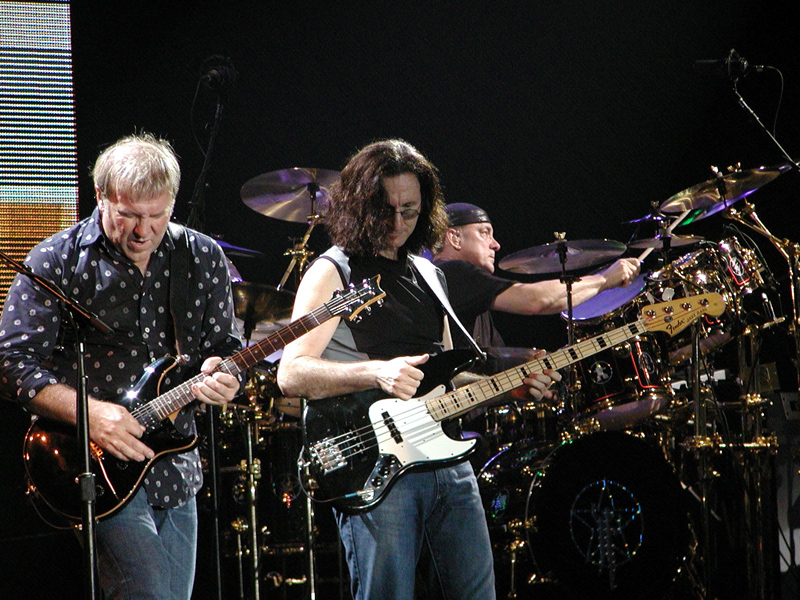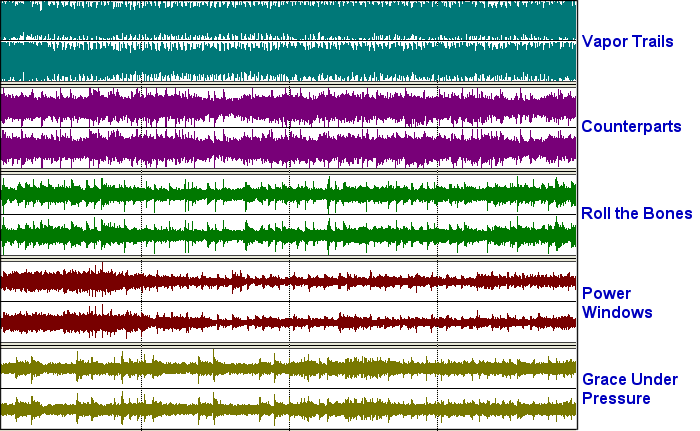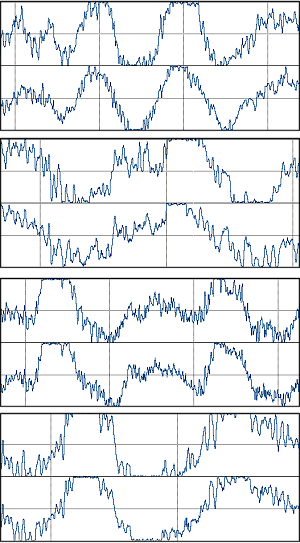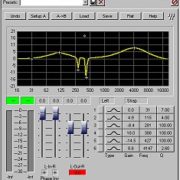PLEASE NOTE: This article has been archived. It first appeared on ProRec.com in September 2002, contributed by then Editor-in-Chief Rip Rowan. We will not be making any updates to the article. Please visit the home page for our latest content. Thank you!
I’m a big Rush fan.
Yeah, I know. Me and 50 million other drummers.
I’ve been listening to this band since they showed up on my radar in the late 1970s, and have always followed their tours and new albums. I admit that I fall into the camp of wistful fans who yearn for a return to the art-rock glory days of the band (which pretty much makes me an old burnout) but I still like to hear the new stuff and see what these dudes are up to. And, Rush’s return to a more guitar-oriented (and acoustic-drum-oriented) sound has reignited some of my interest in their performances. Rock music is all about the guitar, and few people are as interesting to listen to as Alex Lifeson. And don’t even get me started about Neil Peart.

The other interest I have in this band is that they have always been at or near the forefront of recording technology. They were one of the first bands to jump into digital recording, where they definitely learned some tough lessons, but the engineering work done on their CDs has usually been top-notch. I can almost always learn something about engineering from listening to the production of a Rush CD.
So you can guess that it was with much anticipation that I awaited my first real listen to the band’s newest CD, “Vapor Trails”. Reviews heralded this album as one of the hardest-rocking Rush albums in some time, with a strong focus on guitars, powerful drumming, excellent bass work, and some of the best songwriting to come from the band in years. And, in listening to the CD, I found all of these things to be true. This is easily my favorite collection of Rush songs in years, maybe decades. It’s incredible work and I earnestly hope it reflects a new and sustainable direction for this great band.
However, there was one fact that the reviewers had all left out: this CD sounds like dogshit.
Perhaps you think I’m being a little strong. I think not. This is without prefix or suffix the worst sounding Rush CD ever made. In fact, it is so bad that I cannot listen to more than a few songs before I just have to turn it off.
What’s the cause of this sonic catastrophe? There’s no secret here: loudness. Vapor Trails is just the latest CD to fall victim to the current craze of LOUDER IS BETTER production. Rush is not alone. Most of the current crop of rock CDs have been punished by the LOUDER IS BETTER process, and I know I am not alone when I say, once and for all, ENOUGH IS ENOUGH.
Where the damage was done on the Vapor Trails CD is impossible to say for sure. Usually, LOUDER IS BETTER is inflicted by the mastering engineer. It is relatively evident from an investigation of the audio on Vapor Trails that the problems arose in mixing or mastering, not in tracking. However, the audio on this disk is so bad that had I been the record label, I would have sued the responsible party for malpractice. Unfortunately, I know all too well that the record label is almost certainly the culprit in this crime, and the band and its fans the victims.
The Label is the Culprit
Record labels have never really understood what makes a record “sound good” and frankly, few even care. Many of the people who sign artists don’t understand their music at all. Instead, they are able to pick up on musical trends, and replicate those trends across the ranks of their artists. Artists that fit into the trend are fed, the rest are starved.
Over the past few years, record labels have increasingly attempted to dictate to the artist and producer the target volume level of the CD. For some reason, record labels have it in their head that “LOUD” equals good, and therefore, “LOUDER” equals better. Not caring to understand even the basics of audio, these morons simply demand more volume (typically from the mastering engineer) and really don’t understand – or care – about the consequences of their demands.
Mastering engineers are caught in a Catch-22. If they do not deliver a product that is appropriately LOUD, then they are consdered inept by the labels and are shunned. If they refuse to destroy the artist’s music, then they aren’t being “team players” and quickly fall out of favor. But if they provide what the customer demands (and remember, the label, not the band, is the customer) then they ruin a perfectly good piece of music, and they know that sooner or later, people are going to figure out why the sound is so horrible, and then the mastering engineer will be blacklisted for having followed orders.
Having said all that I really don’t know what I would do in their shoes. If someone offered YOU the opportunity to master a Rush CD, and then told you that you would have to destroy the sound quality in order to get the job, how would you respond? It isn’t a clear or easy choice.
However what is clear as day is that this CD sounds like dogshit. I cannot say this enough. My God, this thing sounds terrible. It is hands-down the worst sounding CD I own.
Perhaps a brief education about the history of the problem is in order.
A Little History Lesson
Everyone has heard the CD That Is Too Quiet. This is usually your (or your buddy’s) first demo. You pop it in and you can barely hear the music. There are many reasons for the CD That Is Too Quiet, and it isn’t my intention here to go into them all. But we’ve all heard (or made) the CD That Is Too Quiet and regretted it.
Professional engineers, particularly the ones working with digital in the early days of that medium, made some CDs That Were Too Quiet. Usually, these guys had lots of skill and great intent. You get the whole CD laid out in the DAW, and you’ve been careful with your gain structure, and there’s lots of headroom. In one or two places, there’s a freak transient that comes close to 0 dB, but overall the peaks are hitting near –9 or lower, and there’s tons of dynamic range. In general these professional CDs sound pretty good – sometimes excellent – but the average level of the audio is relatively low.
Most older recordings tracked and mixed to analog didn’t suffer these problems. The reason was that traditionally engineers would saturate the analog tape by running it hot, essentally using the tape as a peak limiter at every stage of the process. As a result there are usually no errant peaks in an analog rock recording, and for this reason most rock records are still recorded to analog tape.
The problem with the CD That Is Too Quiet is this: when you put the CD into the CD changer, it’s YOUR music that nobody hears. Well, folks, if you’re a record label exec, that’s the ONE problem that you know just cannot be allowed to stand. Quiet CDs became synonymous with Amateur Recordings, and Loud CDs became synonymous with Professional Recordings.
Understandably, nobody wants to have the quietest CD in the CD changer. Nobody wants to have the one CD that doesn’t get heard. The problem with the LOUDER IS BETTER approach is simply that with any medium – digital or analog – there is only so much signal that will fit in the space provided. Beyond a point, you cannot gain anything without losing something.
Why Be Normal?
The idea behind peak limiting of digital audio started simply enough. Before people got the idea to use a peak limiter on their digital audio, the process of normalizing was used. Normalizing is a strange word that simply means “increase the volume of the signal by whatever amount is needed to bring the highest peak up to 0 dB, full-scale. Normalizing audio during a CD transfer is simply an easy way to get the audio as loud as it can be without changing the dynamics whatsoever. From an audiophile point of view it is the proper technique to get the hottest signal on CD with no distortion of the signal at all.
However, as we’ve discussed, if you have just one transient that jumps out of the signal, then you really can’t get much extra volume out of the signal. Here’s where limiting comes into play: if we just tame the small number of peaks that are eating up the dynamic range of the signal, then we can get the entire signal hotter. Used properly, this results in an imperceptible change to a small number of peaks in the signal and the whole signal can be made louder, sometimes considerably so. This approach achieves the maximum volume while still preserving virtually all of the original signal.
People discovered that with modern limiter technology, you could pretty much ride ALL of the peaks, and squeeze another few dB of gain out of the signal. This approach definitely changes the sonics of the signal because the peaks are being limited throughout the song. However, depending on the source material and your personal taste, this approach to limiting can sound pretty good as long as it is kept in the range of reasonableness. A lot of CDs have been mastered using this approach to limiting, and most of them still sound pretty good.
However, the latest trend is LOUDER IS BETTER. This approach basically ignores any distortion caused by limiting and seeks to make the audio as loud as possible. The idea is to peg the meters and keep them pegged. As a result the signal is just ruined.
WHY IS THE LOUDER IS BETTER APPROACH THE WRONG APPROACH? BECAUSE WHEN ALL OF THE SIGNAL IS AT THE MAXIMUM LEVEL, THEN THERE IS NO WAY FOR THE SIGNAL TO HAVE ANY PUNCH. THE WHOLE THING COMES SCREAMING AT YOU LIKE A MESSAGE IN ALL CAPITAL LETTERS. AS WE ALL KNOW, WHEN YOU TYPE IN ALL CAPITAL LETTERS THERE ARE NO CUES TO HELP THE BRAIN MAKE SENSE OF THE SIGNAL, AND THE MIND TIRES QUICKLY OF TRYING TO PROCESS WHAT IS, BASICALLY, WHITE NOISE. LIKEWISE, A SIGNAL THAT JUST PEGS THE METERS CAUSES THE BRAIN TO REACT AS THOUGH IT IS BEING FED WHITE NOISE. WE SIMPLY FILTER IT OUT AND QUIT TRYING TO PROCESS IT.
I bet you couldn’t even finish reading that paragraph. Get the idea? If louder was really better, then all print media would be printed like the above paragraph.
Editor’s note: immediately after printing this article, Senior Editor Bill Park mentioned in a Discussion Forum thread that one point that had not been made in this article was the psychological effect of LOUDER IS BETTER on the listener – that people tend to either turn the music off, tune the music out, or get away from it. Of course, that is precisely the point of the paragraph above in all caps. Bill had actually fallen victim to the point he was trying to make – the all-caps paragraph was so overwhelming to his brain that he either couldn’t stand to read the whole thing, or his brain failed to process the message. The irony of this is just amazing, and clearly proves the point that Bill was trying to make: LOUDER IS BETTER means that people actually fail to even hear the music.
Case Study
I went back through some of my collection of Rush CDs to see if my theories held true. What I found was pretty shocking, but not surprising. It turns out that Rush is just a microcosm of what has been going on in music for the last five or so years.
Here is a side-by-side picture showing a sample of audio from five different Rush CDs. On the top is the latest CD, Vapor Trails (2002). Below that, going back a few years, is a sample from the Counterparts CD (1993). Going back a year is a sample from the Roll The Bones CD (1992). Next is 1985’s Power Windows, the first Rush CD to be recorded entirely digitally. On the bottom is a sample from the Grace Under Pressure CD (1984) which immediately preceded Power Windows and was recorded to analog.

A numerical analysis of these tracks offers more insight into the same information
| Peak Amplitude | # Clipped Samples | RMS (average) Power | |
| Vapor Trails | 0 dBFS | 110 | -9.5 dB |
| Counterparts | 0 dBFS | 5 | -14 dB |
| Roll the Bones | 0 dBFS | 5 | -17 dB |
| Power Windows | -.3 dBFS | 0 | -18.5 dB |
| Grace Under Pressure | -.3 dBFS | 0 | -18.5 dB |
Power Windows and Grace Under Pressure are classic examples of the Normalization approach to CD transfer (note: I have no earthly idea how any of the CDs were actually mastered, but they still serve as excellent examples of the various approaches to mastering I will discuss). Both Power Windows and Grace Under Pressure show no signs of brickwall peak limiting. Most of the peaks fall well below 0 dBFS, but each one had one peak that hit -.3 dBFS. In the mid-eighties, -.3 dBFS was considered the loudest signal that was safe to put on a CD, since some CD players at the time would treat a 0 dBFS sample as an error. It seems apparent that these two CDs were normalized immediately before transfer to CD master and were not processed with a brickwall limiter.
Roll the Bones shows some signs of peak limiting, but the limiting was a very safe approach. Most of the peaks are just a little below 0 dBFS, but several of them do hit 0 dBFS. However, investigating those samples shows that most of the transient is preserved, leading me to believe that the limiter was used primarily as a safety device, rather than with a deliberate attempt to knock the peaks off of the transients. A little gain was achieved vis-a-vis the older songs: the Roll the Bones sample is 1.5 dB louder than the samples from Power Windows and Grace Under Pressure.
Counterparts is indicitive of an aggressive approach to limiting that still seeks to preserve as much fidelity as possible in the signal. Here it is pretty clear that the limiter was used to shave off a few dB from most of the peaks. Although the analysis software reported that the Counterparts sample and the Roll the Bones sample both had 5 “clipped” samples, investigation of the peaks shows a more consistently limited signal on the Counterparts CD. Not surprisingly, this CD is noticeably louder than the older three samples used in this test. Counterparts is 3 dB louder than Roll the Bones and 4.5 dB louder than Power Windows and Grace Under Pressure. As you probably know, that means that you will perceive Counterparts to be twice as loud as those older CDs. And, while the trained ear will recognize the sound of Counterparts as having been processed with a limiter, the sound is still relatively open and more-or-less unmolested. Audiophiles will probably disagree with me here, but in the world of rock music, a little bit of peak limiting doesn’t necessarily ruin the sound.
But what is going on with Vapor Trails? The numbers quickly report the truth we were hearing with our ears. The average volume is a whopping 4.5 dB louder than Counterparts. But where Counterparts was able to achieve a 4.5 dB volume boost with almost no increase in audible distortion, in the Vapor Trails sample almost every peak is clipped, many of them severely so. And, as we shall see, the limiting is so severe that the songs have no punch, and just slam out of the speakers like a loud blast of white noise.
What Price Volume?
Have a look at this and tell me what you see:

What you are looking at is a serious square wave. Note in the top swing of the clipped wave how the high-frequency harmonics have had all of their peaks shaved off? This is why clipping sounds harsh. Now note how in the lower portion of that wave the bottom is just perfectly squared off? That’s a pulse of white noise. Now note how all of the peaks in this signal are all hitting the top of the scale? This is why the CD has no punch. A powerful blast of the kick drum should be louder than the rest of the signal and should have a sharp transient on the front of the wave. In the case of this song, however, it just produces a quick blast of distortion and a dull thudding sensation.
If there was one or two places on the CD that had been tortured like this, it would be one thing. But that’s not the case. Every peak on the whole album is wrecked. In fact I didn’t have to try to find an ugly picture to illustrate the damage: the question was “which one do I choose?”

You’re probably thinking, “You’ve got to be kidding!” But I’m not. These are just a few of the thousands of examples of the trashed audio on the Vapor Trails CD.
Now, anybody with any experience in audio should be able to look at these examples and immediately know, “That won’t sound good.” And, it doesn’t. So the question is, why is this CD wrecked, and by whom?
Notice how, when the signal clips, the whole signal is being destroyed? If this had been caused by an error during tracking (say, the kick drum track was too hot) then there would still be detail left in the signal. Therefore, we know this distortion was caused either during mixdown or during mastering. I’d be willing to bet that it was caused during the mastering process. At least I hope it was during the mastering process. At least that way there’s some chance that one day I’ll be able to buy a remastered copy of Vapor Trails that’s worth listening to.
But before you think I’m accusing the mastering engineer of incompetence, remember my earlier discussion. I doubt very seriously if any engineer actually wanted to do this to the music. No, only the decision of a record label executive could destroy music like this.
What a shame. What a crying shame.
Solutions
I can sit here and rant all day long. The real question is: what can be done about it?
The good news is that LOUDER IS BETTER is definitely a self-correcting problem. Because this stuff just plain sounds bad, and sooner or later (hopefully sooner) people are going to realize that the music doesn’t “rock more” or “cut through better” but that it’s just plain annoying.
Because the simple truth is that audio such as this does NOT cut through better. In fact, in all probability this song will be QUIETER on the radio than, say, Roll the Bones! How, you may ask, could this be possible?
The answer lies in the simple fact that the radio station uses compressors and limiters as well. The station’s signal processors are also designed to get the hottest signal on the air. As such, they expect a certain amount of peaks in the signal. A broadcast processor that can’t “see” any peaks is simply going to clamp down on the whole signal. In the end, the song is no louder (and maybe quieter) than other, more dynamic material – AND it is further penalized because it has no punch and is very harsh.
So to you record executives who think you have identified the magic way to ensure that your song is louder on the radio, think again. It just isn’t so.
And as far as being the loudest CD in the CD changer, has it ever occurred to anyone just exactly how annoying that is? Let me tell you, you won’t catch me loading Vapor Trails into MY changer with a bunch of older Rush CDs. It sticks out like a sore, bleeding thumb.
As I have said before, Rush is not the only band to fall victim to LOUDER IS BETTER. As a matter of fact I have had some of the CDs which I have engineered fall victim to LOUDER IS BETTER. I don’t mean to pick on Rush, one of my favorite bands of all time. However, let’s look at some facts.
More than most other bands, Rush has proved itself capable of consistently delivering music that pleases the fans. Rush’s success has not come through a string of chart-topping hits, clever marketing, or sex appeal. Rush’s success comes from its close alliance with its fans.
I wonder what would happen if Rush fans complained about the sound of this record? To my mind, the only thing that the record company mooks will pay attention to is audience disapproval. So I encourage you to write to your favorite bands and tell them that you will quit buying their CDs if they insist on trying to make them the loudest CDs you own.
Oh, and when you write them, WRITE IN ALL CAPS.


